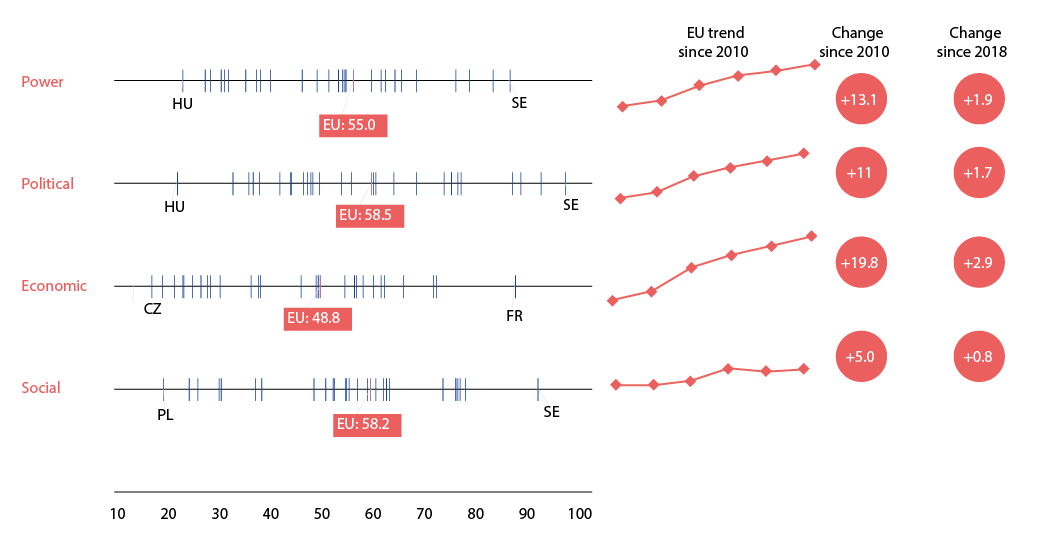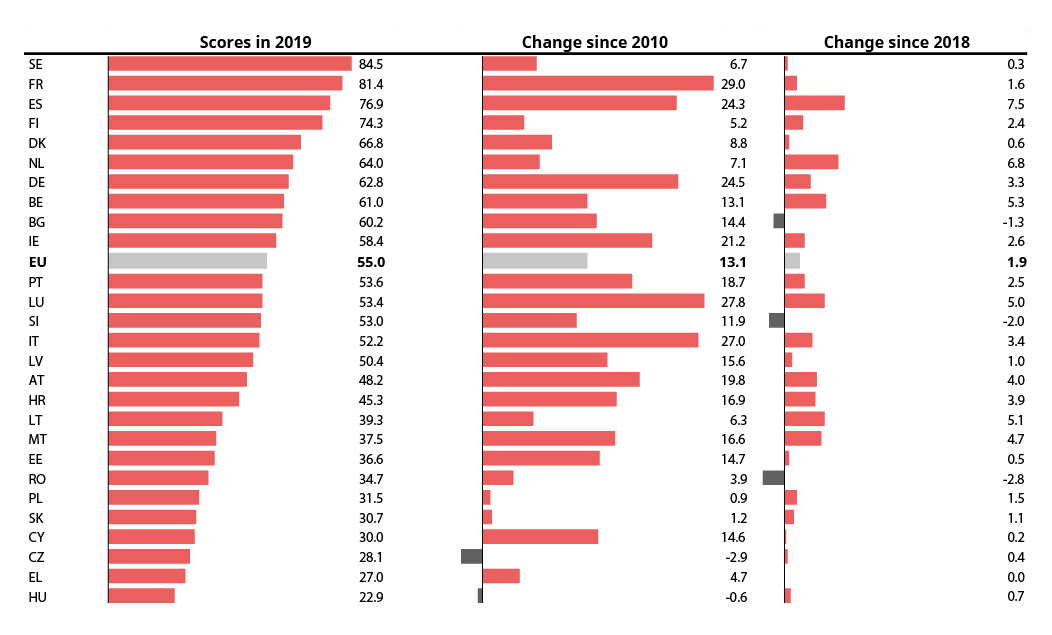Decision-making gains drive gender equality progress
Since 2010, the EU score for the domain of power[1] has increased by 13.1 points, and between 2018 and 2019 it increased by 1.9 points. Nevertheless, the overall score of 55 points remains the lowest of all the domains.
Gender balance gains in the subdomain of economic decision-making, such as on boards of the largest companies and national central banks, has driven overall progress. There was an increase of 2.9 points between 2018 and 2019, and of 19.8 points in total since 2010. This change was triggered by binding legislative measures and other government actions in several countries. These peaked between 2012 and 2016 and have noticeably slowed since.
Gender equality in political decision-making has advanced by 1.7 points since 2018, and by 11 points overall since 2010. Here, too, government action has driven progress. From 2010 to 2019, countries with legislative electoral quotas have, on average, nearly doubled the proportion of women in parliament, compared with those without such quotas (+ 9.3 p.p. compared to + 4.8 p.p.) (EIGE, 2020a).
Progress on having more women in decision-making in research, the media and sport has been marginal, with a score increase of 0.8 points since 2018 and of 5.0 points between 2010 and 2019. These are the lowest increases of all power subdomains (Figure 16). The biggest gender imbalance is in sports, with just 17 % of women on the boards of the 10 most popular national sports federations in 2020.
Nationally, gender balance in decision-making has been making rapid progress since 2010 in France (+ 29.0 points), Luxembourg (+ 27.8 points), Italy (+ 27.0 points), Germany (+ 24.5 points) and Spain (+ 24.3 points). For 11 other countries (IE, AT, PT, HR, MT, LV, EE, CY, BG, BE and SI), score gains in the domain of power vary from 21.2 points in Ireland to 11.9 points in Slovenia. All other countries score gains in the domain of power is below 10 points, and for Czechia (-2.9) and Hungary (-0.6) is negative.
Since 2018, the greatest advances have been in Spain (+ 7.5 points) and the Netherlands (+ 6.8 points), followed by Belgium (+ 5.3 points), Lithuania (+ 5.1 points) and Luxembourg (+ 5.0 points). The countries that have regressed since 2018 are Romania (– 2.8 points), Slovenia (– 2.0 points) and Bulgaria (– 1.3 points) (Figure 17).
Spain gained ground on gender balance in several decision-making bodies and institutions in 2019, particularly in government and on the boards of public broadcaster RTVE and the 10 most popular national sports federations. The Netherlands has moved closer to gender parity on the governing boards of the national central bank and the Netherlands Organisation for Scientific Research, while Belgium saw significant improvement in gender balance in the central bank (on the board of directors and the Council of Regency) and in government.
Progress in Luxembourg and Malta was similarly driven by greater gender balance on the boards of both national central banks, a public broadcaster in Luxembourg (Radio 100.7) and the Malta Council of Science and Technology. In Lithuania, more women are now in parliament and government following elections in 2020, and more women are on the board of the national central bank.
However, gender parity in decision-making suffered a setback among public broadcasters in Bulgaria (BNR - Bulgarian National Radio, BNT – Bulgarian National Television) and Romania (TVR – Romanian Television), while in Slovenia there were reversals in government, parliament and on the board of the national broadcaster RTV Slovenija.
Figure 16. Scores for the domain of power and its subdomains (2019), and changes over time
Figure 17. Scores for the domain of power (2019), and changes since 2010 and 2018, by EU Member State

